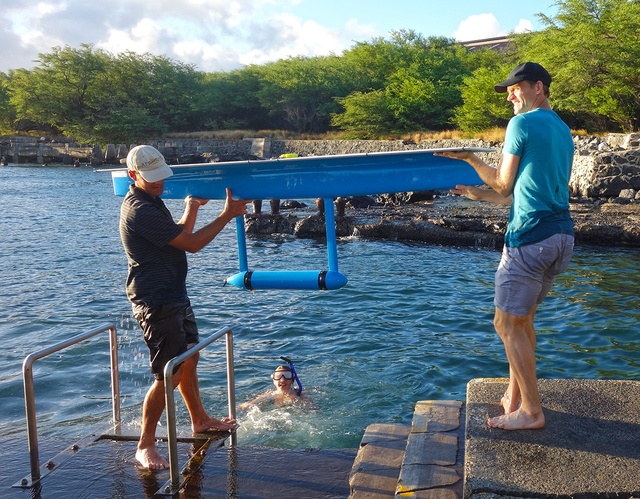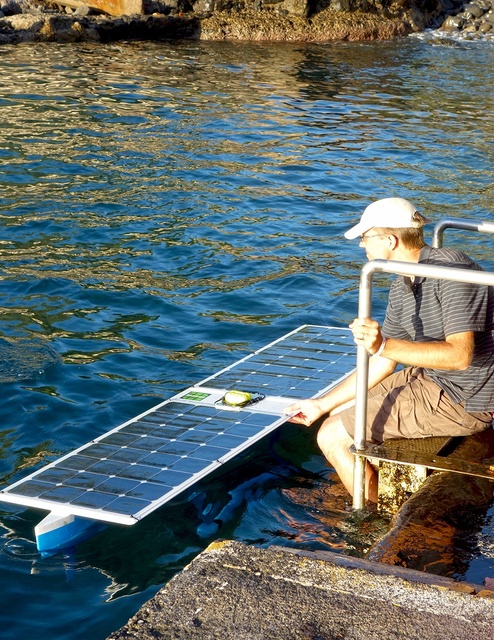NORTH KOHALA — As the sun began its slow descent into the Pacific late Friday afternoon, a handful of locals were enjoying a pau hana swim at Mahukona Harbor. At the north end of the dock, a visiting family gazed
NORTH KOHALA — As the sun began its slow descent into the Pacific late Friday afternoon, a handful of locals were enjoying a pau hana swim at Mahukona Harbor. At the north end of the dock, a visiting family gazed intently out to sea, their raised hands shielding their eyes from the glare, as if searching for something in particular.
At 6:16 p.m., their raised voices could be heard cheering as a small craft entered the harbor. It was a dream come true for 39-year-old Silicon Valley resident Damon McMillan, as his unmanned solar-powered surface vehicle (USV) named “SeaCharger” became the first of its kind to cross an ocean on solar power alone.
A hobby he started two-and-a-half years earlier, the 8 x 22-inch boat reached Mahukona after 41 days and roughly 2,300 miles at sea. McMillan and his brother, Justin, lifted the boat out of the water after waiting on the shore for more than two hours.
Using a tracker app on his phone, he was able to pinpoint the vessel’s location and send commands every seven minutes to maneuver it into the shore. After several attempts, it headed straight for the harbor. His wife, Jillaire, jumped into the ocean to greet it.
“It’s not a moment too soon, as tropical storm Darby is scheduled to hit Hawaii on Saturday,” McMillan said.
The boat was in good shape, with only several barnacles affixed to the bottom.
The project started in McMillan’s garage in late 2013.
An MIT graduate with his bachelor of science in aeronautics and astronautics, he and his friends, JT Zemp, Troy Arbuckle and Matt Stowell, assembled the craft using “a few pieces of ordinary technology to accomplish an extraordinary feat.” Renogy, a renewable energy company based in Ontario, Calif., donated two solar panels to make the project possible.
After several test runs earlier this summer, the 60-pound USV was launched from Half Moon Bay, Calif. on June 11. Powered by a solar battery, the distance the vessel traveled daily varied, largely influenced by clouds, sunshine and currents. McMillan was able to follow the SeaCharger via a tracking app on his smartphone that he updated hourly each day.
“It’s a personal project,” he said. “Challenges came from clouds that impeded the battery from fully charging, thus slowing the journey. One day, SeaCharger went 42.7 miles that were actually in the wrong direction.”
On weekdays, McMillan works as a senior mechanical engineer for Liquid Robotics. He came up with the idea for a solar-powered boat after hearing about a project started by Tiverton, Rhode Island students in 2010 to send a 12-foot solar-powered craft from Rhode Island to Spain. Launched in 2013 and relying solely on pre-programmed commands and information collected through sensors, the boat went missing after traveling more than 1,000 miles.
Another unsuccessful voyage was made in early 2016 by Solar Voyager using an autonomous boat designed in Singapore, built with a hull made in the U.S. and electronics made and assembled in Singapore. That vessel hoped to cross the Atlantic Ocean as well, but to no avail.
Learning from these attempts, McMillan designed a smaller boat made largely of Styrofoam with a motor under the solar panels.
“Technical challenges came from the motor that kept turning off. Fortunately, it has a built-in ability to handle that, and I can give it commands to restart the motor,” he said. “When it first started out, I was modifying the route to try to take advantage of winds. The currents were a challenge as they became stronger near Hawaii.”
With what’s been learned from this small but mighty feat, McMillan said he will change a few things in the boat’s software, clean it up and send it out again to see how much farther it can go before it dies.
Other than that, he has no plans to continue the project, and for the most part, is glad it’s over.
“To make this into a useful product, the solar-powered boat would take a lot more development and would probably end up being very different from what it is now,” McMillan said. “I actually think that there’s more to learn from this voyage for individuals and hobbyists, namely that by mixing some of the amazing technology we have available today with a lot of effort and patience, it’s possible to do some pretty cool things.”




